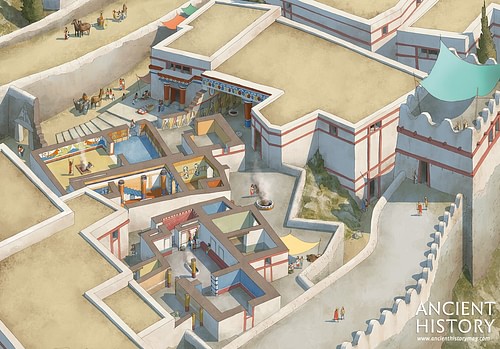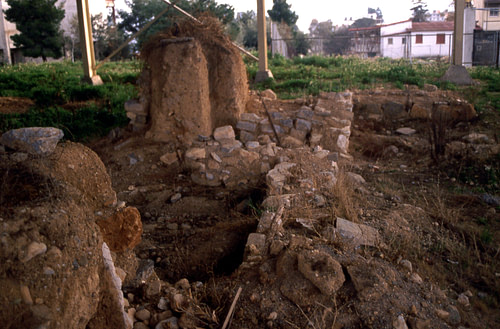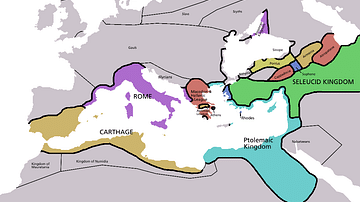
The Greek Dark Age (c. 1200 to c. 800 BCE, overlapping with the Iron Age, c. 1200-550 BCE) is the modern-day term for the period in Greek history following the Bronze Age Collapse when the Mycenaean Civilization fell and the Linear B writing system was lost, giving the era the designation "dark" because no contemporary written accounts of it exist.
The Mycenean Civilization (c. 1700-1100 BCE) and earlier Minoan Civilization (2000-1450 BCE) raised large palaces in urban centers including Tiryns, Pylos, Mycenae, and the Minoan Knossos, that regulated trade and supported scribes who kept accounts and recorded the development of culture. The Myceneans replaced the Minoans as the major power in the Mediterranean, and when their civilization collapsed, the literate upper class vanished along with the socio-economic system they had created. Scholars Christopher Scarre and Brian M. Fagan comment:
Current theories of the "dark age" do not look to a wholesale replacement of the Greek population but to a decapitation of Mycenean society – the fall of the aristocrats, with their palaces and clay tablets, leaving the uneducated villagers and farmers, with only their oral traditions and village-farming economy. (272)
While this may be true, the "dark ages" were not as "dark" as they were once thought to be. The Greek Dark Age is characterized by:
- Political fragmentation
- Collapse of trade networks
- Economic decline
- Loss of material culture
- Population decline
- Decline in art, cultural pursuits, wealth, and writing
In the case of the Greek Dark Age, the writing system vanished completely. Beginning in the 19th century, scholars blamed the Greek Dark Age on the Dorian Invasion – claiming that Greeks known as Dorians destroyed the Mycenean Civilization and uprooted Greek culture for 400 years – but this has been rejected, and the so-called Dorian Invasion is now considered more of a migration. The Dark Age is also no longer thought to be so "dark" because Greek culture and commerce continued after the fall of the Myceneans, just not at the same level as before.
It is now understood that the Greek Dark Age followed the Bronze Age Collapse that either eliminated or adversely affected all of the civilizations of the Mediterranean and Near East, but, unlike the Hittites (to name just one example), the Greeks were able to survive the collapse to emerge from their dark age into the Archaic Period (8th century to c. 480 BCE), the development of an alphabetic scipt, and the rise of the city-states of ancient Greece. The Greek Dark Age, therefore, is now seen as more of a fallow period leading to an abundant cultural harvest rather than the sterile period of decay it was defined as in the 19th and 20th centuries.
Mycenaean Civilization
The Myceneans established over 100 urban centers throughout Greece and Anatolia, which were linked culturally, if not politically. The social structure of Mycenean civilization is unclear, but it has been established that the palace operated on its own economy based on luxury goods while the economic foundation of the nearby village (or villages) was agricultural. The palace may or may not have controlled the economy of the village, but, together, they produced the goods used in trade throughout the Mediterranean.

In any Mycenaean region, the palace dominated the landscape, as with Mycenae, built on a hill 278 meters (912 ft) above sea level with walls 13 meters (42.6 ft) high and 8 meters (26 ft) thick. These were later referred to as Cyclopean Walls because it was believed that only the enormous creatures known as Cyclopes could have placed them. The walls surrounded the palace complex which included the Megaron, the palace center, which featured a great circular hearth thought to have been the throne room where the ruler called his assemblies for conference. Walls of the Megaron were decorated with frescoes as were the rooms of the palace generally.
The wealth of the palace was contrasted with that of the village where the people lived in mud-brick houses built on foundations of stone without ornamentation. Lacking any kind of records, it is unknown how prosperous the villages were, but after the collapse of the Mycenean Civilization, this no longer mattered as those mud-brick houses were all that survived intact.
Bronze Age Collapse & the Dark Age
The Bronze Age Collapse (also known as the Late Bronze Age Collapse) is a modern-day term for the widespread and rapid decline of civilizations in the Mediterranean and Near East beginning c. 1200 BCE. The causes of the collapse include:
- natural catastrophes (earthquakes)
- climate change (causing drought and famine)
- internal rebellions (class wars)
- invasions (primarily by the Sea Peoples)
- disruption of trade relations/systems collapse (political instability)
All of the above have been cited as causes for the collapse of the Mycenean Civilization and the resultant Greek Dark Age. Political instability may have resulted from class wars between the people of the village and those of the palace over the inequitable distribution of wealth, though this claim is speculative. Climate change and natural catastrophes, as well as invasions by the Sea Peoples (who were instrumental in the fall or decline of other civilizations such as the Hittites and Egyptians), seem to be more certain causes. Scholar Bettany Hughes, among others, cites greed, which encouraged war, as the primary cause of the Mycenean collapse:
The city birthed a particular kind of self-contained civilization and incarnated the self-destructive paradox of what it is to be civilized: the pressing desire for more, for what we do not have. And so, the rulers of the Aegean Bronze Age got greedy; peering over the horizon, they saw not just another citadel-state like theirs, but potential plunder…There were triumphs and then there was tragedy. (Norwich, 125)
It is unclear what actually happened, however, and all that is clearly known is that the great palaces and production centers of the Myceneans abruptly declined between c. 1230 and c. 1100 when several of these sites were destroyed, some bearing the marks of fire, while others remained untouched but were abandoned. These latter sites were sometimes repopulated but on a far more modest scale. The sites of the so-called Post-Palatial Period provide no evidence of the kind of opulent wealth of the Mycenean era.

Those who lived in the abandoned palace complexes and those who continued living in the mud-brick houses surrounding them seem to have been at the same economic level. There is no evidence, in the early part of the Dark Age anyway, of long-distance trade, and ceramics show a marked decline in style. There is no evidence of a writing system of any kind, and agricultural production declined as did the population. The entire civilization of ancient Greece seems to have paused for approximately 200 years before it began again; yet in those 200 years, there were clearly significant developments that enabled the kind of industry, trade, and expansion seen from c. 1050-800 BCE.
Dark Age Cultural Development
Following the Bronze Age Collapse, no monumental stone structures were built, and, as noted, those that were not destroyed declined and were inhabited, seemingly, by squatters. The relationship between the decline in agricultural production and the decline in population continues to be debated, but it seems that the lack of basic foodstuffs encouraged the population decline, which in turn hampered food production. This is a generalization, however, as some regions, including Attica and Euboea, continued more or less as they had before, only at a more modest level.
As noted, the relationship between the palace and the village during the Mycenean era is unclear but, during the Dark Age, the village came to be centered around a strong man who became the authority, as noted by scholar Thomas R. Martin:
In the Dark Age society, men dominated the distribution of justice, exercising direct control over their family members and household servants. Others outside their immediate households would become their followers by acknowledging their status as leaders. A powerful man's followers would grant him a certain amount of authority because, as the followers were roughly equal in wealth and status among themselves, they needed a figure invested with authority to settle disputes and organize defense against raids or other military threats. In anthropological terms, such leaders operated as chiefs of bands. A chief had authority to settle arguments over property and duties, oversaw the distribution of rewards and punishments, and usually headed the religious rituals deemed essential to the security of the group. At the same time, his actual power to coerce recalcitrant or rebellious members of his band was limited. (48)

The chief's authority was granted by the males of the band he presided over and, if he abused his position or was in some way no longer regarded as worthy of his position, he was replaced. This social paradigm is known through Hesiod (l. 8th century BCE) who described it in his Works and Days. Precisely when this model was implemented is unknown but, by Hesiod's time, it seems to have been firmly in place and would eventually develop into the concept of kingship and, in Athens, democracy.
During the early Dark Age, there were no cities for a king to rule over, however, and no armies to send on campaigns of conquest. The village leader organized defense against, or mobilization of raids on, other villages. By the 10th century. BCE, however, significant changes are evident in social development, as Scarre and Fagan note:
For several centuries, Greece remained a basically peasant society without cities, without writing, and without architecture of any significance. Yet as early as the tenth century BC, there were signs of economic revival. This cultural and economic recovery, continuing during the ninth and eighth centuries BC, had both domestic and international components. At home, population levels that had fallen dramatically at the end of the Mycenean Age began to rise once again, and prosperity grew. Overseas, there were renewed contacts with the ports around the eastern Mediterranean, and luxury items from Egypt and Cyprus were placed in graves at Lefkandi on the Greek island of Euboea. (273-274)
Lefkandi
In the 1960s, the now-famous site of Lefkandi on Euboea was discovered, revealing an ancient Greek settlement dated to c. 1200 to c. 950 BCE. The site features a number of cemeteries with grave goods that establish trade between Euboea, Cyprus, Egypt, and the Levant. Lefkandi is a prime example of a community that seems to have been relatively unaffected by the Greek Dark Age. Based on the large, excavated structure known as the "Hero's Grave", the community seems to have been led at some point around 950 BCE by a powerful, wealthy chieftain and, possibly, his wife. Who they were and how they came to rule (if they did) is unknown, but it is clear they were important members of an elite aristocratic class at a time when the concept of an aristocracy seems to have been forgotten. Martin comments:
We can only speculate about the various ways in which families might have originally gained their designation as elite and thus become entitled to pass on this wealth and status to those descendants able to maintain them. Some families in the Dark Age might have inherited an elite status as survivors of prominent families of the Mycenean Age that had somehow managed to hold on to wealth or land during the early Dark Age by amazing wealth and befriending less fortunate people who were willing to acknowledge their benefactors' superior status in return for material help; and some might have acquired superior social status by monopolizing control of essential religious rituals that they perpetuated for others to participate in. The ideas and traditions of this social elite concerning the organization of their communities and proper behavior for everyone in them – that is, their code of values – represented, like the reappearance of agriculture, basic components of Greece's emerging new political forms. The social values of the Dark Age underlie the stories told in the Iliad and Odyssey. (42)
The male remains in the Hero's Grave were cremated, wrapped in cloth, and interred in an engraved, bronze amphora from Cyprus. He was buried with a sword and elaborate grave goods. The woman buried with or after him was adorned with jewelry and an ivory-handled knife. The grave and the building constructed over it suggest significant wealth more in keeping with the Mycenean era than the Dark Age, and so, as noted, this marks Lefkandi as one of the sites that seems to have weathered the collapse of c. 1200 BCE easily or, at least, rebounded more quickly than others. For much of Greece by c. 950 BCE, the world of the Myceneans had become a Golden Age of heroes and gods far removed from their daily lives.
Homer & Hesiod
Writing had been rediscovered through trade with Phoenician merchants and the stories told of the great age of heroes, kept alive through oral tradition, were set down by Homer in the 8th century BCE. Martin comments:
The Greeks had relearned the technology of writing as a result of contact with the literate civilizations of the Near East and the alphabet developed there long before. Sometime between 950 and 750 BC, the Greeks adopted a Phoenician alphabet to represent the sounds of their own language, innovating in a fundamental way by introducing vowels as letters. The Greek version of the alphabet eventually formed the base of the alphabet used for English today. Greeks of the Archaic Age swiftly applied their newly acquired skill to write down oral literature such as [the Iliad and Odyssey]. The Greeks believed that Homer, a blind poet from the region of Anatolia called Ionia, had composed the Iliad and Odyssey. Homeric poetry, even if it was put into final form by a single author, grew out of centuries of oral performance by countless Greek poets singing of the deeds and values of legendary warriors and their families...Despite the ancient origins of Homeric poetry, the behavioral code portrayed in its verses primarily reflected values established in the society of Greece of the Dark Age before the rise of political systems based on citizenship. The main characters in the Homeric poems are unmistakably members of the social elite, who are expected to live up to a demanding code of values. (43-44)
The heroes of the Iliad and Odyssey – Agamemnon, Achilles, Menelaus, Odysseus, and others – were modeled on the Dark Age chieftains combined with the images of the wealth and power of the Mycenean period. Hesiod, in the section of Works and Days given as The Ages of Man, compares his era unfavorably with the earlier golden age "which was nobler and more righteous, a god-like race of hero-men who are called demi-gods, the race before our own" (156). In writing of his own time, he comments:
Thereafter, would that I were not among the men of the fifth generation, but either had died before or been born afterwards. For now, truly is a race of iron, and men never rest from labor and sorrow by day, and from perishing by night; and the gods shall lay sore trouble upon them. (170)
The Greek Dark Age was, in fact, "a race of iron" as iron came to replace bronze. Long-distance trade was required in making bronze, but iron was plentiful from the mines of Greece. According to Hesiod, iron was as inferior to bronze as the people of his time to the heroes of the Homeric poems.
Conclusion
Among the other casualties of the Bronze Age Collapse was ceramics, which, as noted, show a marked decline in quality and craftsmanship during the Dark Age but, like other technologies, significantly improved after c. 950 BCE. Textile production, agriculture, writing, and trade also saw renewal from c. 1050 BCE onward. The old social paradigm of the Mycenean age, as suggested by modern scholars at least, of inequitable wealth and power, emerged again as the Dark Age came to a close and the Greek Archaic Period began. Martin notes:
Hesiod reveals that, by the eighth century BC, a state of heightened tension concerning the implementation of justice in the affairs of everyday life had indeed developed between chiefs and peasants…Peasants' ownership of property made them the most influential group among the men, ranging from poor to the moderately well-off, who made up the bands of followers of elite chiefs in late Dark Age Greece. (49)
Even so, the chiefs – quite possibly like the Mycenean monarchs of antiquity – insisted on their innate authority, encouraging the development of their role in the Greek polis – the city-state – where the chief, now king, received his power from the gods and ruled according to their will. This model prevailed throughout Greece in the Archaic Period and into the Classical Period when Athenian democracy was introduced. The democratic concept, however, was nothing new as it had already been understood and practiced in a rudimentary form during the so-called Dark Age of ancient Greece.







